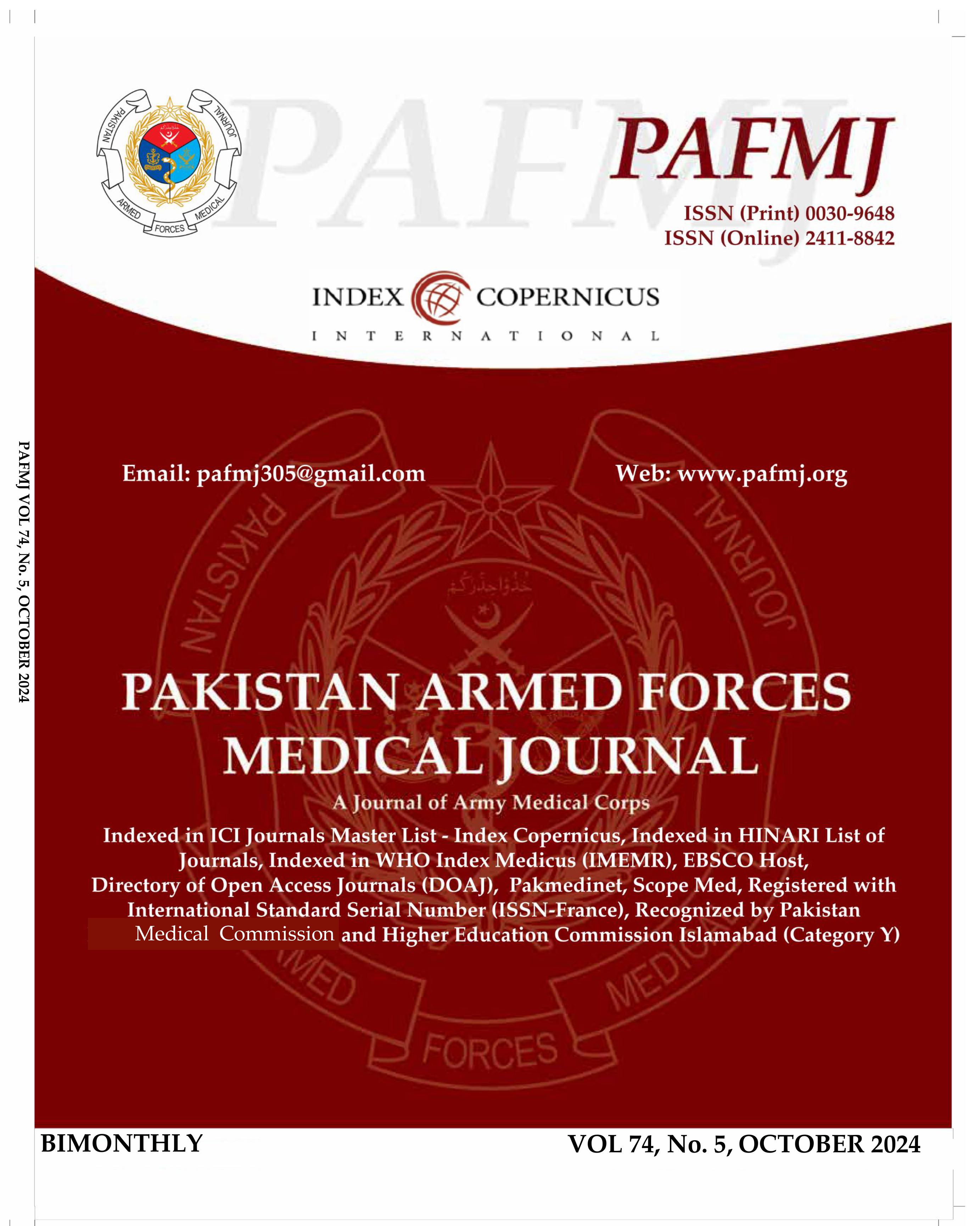The Linkage of Grand Multiparity with Associated Risks During Pregnancy and Childbirth: A Cross-Sectional Study at Tertiary Care Hospital
DOI:
https://doi.org/10.51253/pafmj.v74i5.11358Keywords:
APGAR score, Grand Multiparity, Gestational diabetes, Preterm delivery, Low birth weight,Abstract
Objective: To investigate the risk factors associated with grand multiparityn during pregnancy and childbirth.
Study Design: Cross-sectional study.
Place and Duration of Study: Gynaecology and Obstetrics Department, Pakistan Emirates Military Hospital, Rawalpindi, Pakistan from Dec 2022 to Oct 2023.
Methodology: Three hundred twenty-two (n=322) women from the Pakistan Emirates Military Hospital, labor ward, Rawalpindi, Pakistan, gynecology and obstetrics department participated in this research. Primiparous, Multiparous, and grand multiparous females were included in the study for various demographic, maternal, and neonatal factors.
Results: Primiparous women were higher in number than multiparous and GMP women [202(62.7%), 109(33.8%), and 11(3.4%), respectively). Among the risk factors associated with GMP, there was a greater incidence of miscarriage, i.e., 59.1% in GMP, and Gestational diabetes (27.2% in GMP) and spontaneous preterm delivery (45.4% in GMP) were the two most common problems linked with pregnancy in GMP women. The primary neonatal consequence observed was low birth weight (32.1% in PM), with a prevalence of 32.1%. However, the percentage of infants with an APGAR score below 7 at 5 minutes was higher in the GMP (36.3%).
Conclusion: When compared to other parity groups, grand multiparous Pakistani women face the same risks of maternal and newborn problems. In GMP, advanced age may have a significant impact on pregnancy outcomes. Nonetheless, grand multiparty may not be outlawed, given that women receive adequate prenatal care.
Downloads
References
Al-Shaikh GK, Ibrahim GH, Fayed AA, Al-Mandeel H. Grand multiparity and the possible risk of adverse maternal and neonatal outcomes: a dilemma to be deciphered. BMC Pregnancy Childbirth 2017; 17(1):1-7.
https://doi.org/10.1186/s12884-017-1508-0
Tadese M, Desta Tessema S, Tsegaw Taye B. Adverse perinatal outcomes among grand multiparous and low multiparous women and its associated factors in North Shewa Zone public hospitals: the role of parity. Int J Gen Med 2021; 14: 6539-6548.
https://doi.org/10.2147/ijgm.s333033
Yimer NB, Tenaw Z, Gedefaw A. Pregnancy outcomes in Grand multiparous women: Does parity matter? A comparative study. Ethiop J Reproduct Health 2020 22; 12(1): 11. https://doi.org/10.69614/ejrh.v12i1.247
Akhtar R, Sanodia Afridi RK, Malik NN. Frequency of maternal and fetal outcome in grand multipara women. Khyber J Med Sci 2018;11(3):376-379.
Dasa TT, Okunlola MA, Dessie Y. Effect of grand multiparity on adverse maternal outcomes: A prospective cohort study. Front Public Health 2022; 13; 10: 959633.
https://doi.org/10.3389/fpubh.2022.959633
Khan NR, Parveen S, Begum Z, Qayyum R, Malik R. Grand multiparity and maternal outcome without adequate antenatal care. J Postgrad Med Inst 2017 13; 31(1).
Başkiran Y, Uçkan K, Çeleğen I. Effect of grand multiparity on maternal, obstetric, fetal and neonatal results. Eur Rev Med Pharmacol Sci 2023; 27(22).
https://doi.org/10.26355/eurrev_202311_34466
Nasrullah FD, Khan A, Haque S. Grand multiparity and obstetric complications: a comparative study with women of low parity in a tertiary care hospital. Med Chan 2016 1; 22(2).
Bano B, Yunus S, Yousaf S. Grandmultiparity; A Reappraisal of obstetric outcome. J Soc Obstet Gynaecol Pak 2023; 13(2): 161-5. https:// doi: 10.29054/APMC/2024.1605
Alsammani MA, Jafer AM, Khieri SA, Ali AO, Shaaeldin MA. Effect of grand multiparity on pregnancy outcomes in women under 35 years of age: a comparative study. Med Arch 2019; 73(2): 92. https://doi.org/10.5455/medarh.2019.73.92-96
Alkwai H, Khan F, Alshammari R, Batool A, Sogeir E, Alenazi F, et al. The Association between Grand Multiparity and Adverse Neonatal Outcomes: A Retrospective Cohort Study from Ha’il, Saudi Arabia Children 2023; 10(9): 1541.
https://doi.org/10.1186/s12884-017-1508-0
Abdelmageed E, Bahaeldin H, Nadiah A, Abdelbagi A, Duria R, Ishag A, et al. Maternal and neonatal outcomes of grand multiparity in Khartoum, Sudan. Afr Health Sci 2022; 22(1): 164-171. https://doi.org/10.4314/ahs.v22i1.21
Zafar SM, Naeem S, Noor S, Niaz A. Comparison of malpresentation between multipara and grand multipara. J Soc Obstet Gynaecol Pak 2017 6; 7(2): 82-84.
Alwan BA, Abdulridha AS. Maternal and Fetal Outcomes of Labor in Grand-Multipara Women. Indian J Public Health Res Develop 2019; 10(8).
https://doi.org/10.3389/fpubh.2022.959633
Kadir S, Fatima K, Batool K, Rana MY. Antenatal Complications in Grand Multipara Presented at Tertiary Care Hospital. Ann Punjab Med Coll 2021; 15(1): 69-72.
https://doi.org/10.3390/children10091541
Lee KE, Wen T, Faye AS, Huang Y, Hur C, Friedman AM, et al. Delivery risks and outcomes associated with grand multiparity. J Maternal-Fetal Neonat Med 2022 12; 35(25): 7708-7716.
https://doi.org/10.1080/14767058.2021.1960972
Parveen TA, Iqbal TA, Kausar TA. Grand multiparity and its obstetrical complications at Bahawal Victoria Hospital Bahawalpur. Pak J Med Health Sci 2014; 8(3): 706-708.
Shah PS, Knowledge Synthesis Group on Determinants of LBW/PT births. Parity and low birth weight and preterm birth: a systematic review and meta‐analyses. Acta Obstetricia Gynecologica Scandinavica 2010; 89(7): 862-875.
https://doi.org/10.3109/00016349.2010.486827
Aliyu MH, Jolly PE, Ehiri JE, Salihu HM. High parity and adverse birth outcomes: exploring the maze. Birth. 2005; 32(1): 45-59.
https://doi.org/10.1111/j.0730-7659.2005.00344.x
Teguete I, Maiga AW, Leppert PC. Maternal and neonatal outcomes of grand multiparas over two decades in Mali. Acta Obstetricia Gynecologica Scandinavica 2012; 91(5): 580-586.
Dalfrà MG, Burlina S, Del Vescovo GG, Lapolla A. Genetics and epigenetics: new insight on gestational diabetes mellitus. Front Endocrinol 2020; 11: 602477.
Downloads
Published
Issue
Section
License
Copyright (c) 2024 Arfa Khalid, Bilqees Akhtar, Tehreem Yazdani, Sadaf Zohra, Shazia Firdos Chohan

This work is licensed under a Creative Commons Attribution-NonCommercial 4.0 International License.















